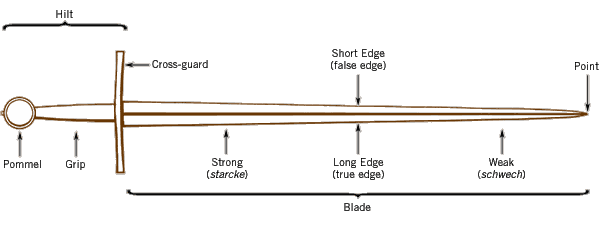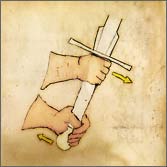| Don't mess with Teodorq or Conan |
| Don't mess with the chicks, neither |
Though they did not pirouette. All the great fightmasters were agreed on that. Exposing your back to your enemy while you spun around was a great foolishness, since the enemy was, you know, trying to kill you?
 For one thing, the longsword was a complicated gizmo. The strong and the weak are parts of the blade, but are translations from MHGerman starke and schwech, and refer to the leverage you get from them. The strong is the part where you try to catch or parry the enemy's blade, and the weak is the part that moves fast and possesses the pointy thing. The fuller is not to let the blood run off but to lighten the blade without weakening it.
For one thing, the longsword was a complicated gizmo. The strong and the weak are parts of the blade, but are translations from MHGerman starke and schwech, and refer to the leverage you get from them. The strong is the part where you try to catch or parry the enemy's blade, and the weak is the part that moves fast and possesses the pointy thing. The fuller is not to let the blood run off but to lighten the blade without weakening it. | Half-swording meant gripping the blade along the strong in close combat. |
 There were two main schools of longsword art: the German and the Italian. The Germans emphasized the attack and the Italians emphasized the defense. Go figure.
There were two main schools of longsword art: the German and the Italian. The Germans emphasized the attack and the Italians emphasized the defense. Go figure. The pommel was more than decorative. TOF had always imagined that the longsword was gripped in both hand like a peasant wielding an axe or Duke Snider a baseball bat, and indeed there are thrusts and guards where this is done. But in many of the postures, the two hands work independently. Primarily, the strong arm (usually the right, as shown) grips the sword below the cross guard, sometimes placing the thumb against the crossguard for better control. The off hand grips down by the pommel and apply the laws of leverage by pulling or pushing on the pommel while the strong hand acts as a fulcrum or moves in the opposite direction.
| Left-handed Ox-Guard. |
But look at the wrists. They are crossed. The strong hand is gripping at the crossguard, but the off hand is crossed under it and is gripping at or near the pommel. This means that if you thrust from this position, you give an additional push on the pommel with your other hand. This gives the thrust greater strength.
The problem with neepery is one can get sucked deeply into it, leading to the dread Infodump in one's writing. So much of what TOF is presently reading will vanish into the narrative, revealing like a fan dancer just enough to show there is substance underneath. So I must take care in the narration not to describe every guard and every thrust.
The German Longsword
Meyer Frei Fechter Guild


Fortunately, we have blogs to overflow into.
ReplyDeleteIf you would care for a private correspondence on the subtleties of long sword combat, TOF (I teach the German tradition), I am at your disposal.
ReplyDelete> So much of what TOF is presently reading will vanish into the narrative
ReplyDeleteOh, I know that.
In my novel I've got an AG drive (think Blish's spin-dizzies) powered by high density batteries. I know the mass of the ships, the escape velocity, the total energy required, the total volume of micro-flywheel batteries in the ships, the energy density of the batteries, and so on.
At one point in the narrative a character falls off a crater wall on the moon. I've got NASA data showing the crater wall height and a spreadsheet showing his acceleration and thus total fall time.
Spacesuits use rebreathers and lunar tunnels need to be filled with air, so I've got reams of notes on potassium superoxide and the compressibility of air in both gaseous and liquid forms.
Tunnels need to be dug, so I've got notes on the length, mass, and cutting speed of various brands of tunnel boring machines and their turning radiuses (it's amazing what's on the web!).
I've got a ex physicist priest arguing with an agnostic about Just War Theory, so I've got chunks of the Catechism all but committed to memory.
- and 99% of that never gets within spitting distance of the final text.
WWJRRTD ?
WWJRRTD?
DeletePublish an appendix.
Excuse me -- appendices.
JJB
I once spent a merry night on the internet working out the minimum dimensions for a nuclear-powered hot air zeppelin capable of lifting a reasonable payload. So far I'm still trying to work out a setting that will disallow internal combustion engines yet has the technology for compact nuclear powerplants and the acceptance of a two-hundred-meter-long hot air balloon cruising over your homes with an air-cooled nuclear reactor strapped to its belly...
ReplyDeleteAs I am sure you may have already noticed, even for something that would seem as technical and obscure as German longsword combat, there are religious disputes regarding the material. :)
ReplyDeleteOne also needs to keep in mind the distinction between Bloßfechten (fighting unarmored, in street clothing) and Harnischfechten (fighting in armor).
While I am only a student and not yet a teacher of German longsword, I would also be happy to assist.
Okay, I'll bite, what is the distinction?
DeleteBloß = blouse
DeleteHarnisch = harness
There are things you can and must do when you or your opponent is wearing a shirt versus when you/he is wearing an iron suit.
@Alister
ReplyDelete> I once spent a merry night on the internet working out the minimum dimensions for a nuclear-powered hot air zeppelin capable of lifting a reasonable payload. So far I'm still trying to work out a setting that will disallow internal combustion engines yet has the technology for compact nuclear powerplants and the acceptance of a two-hundred-meter-long hot air balloon cruising over your homes with an air-cooled nuclear reactor strapped to its belly...
Stop posting comments here and get back to work - I want to read this book!
Just in case this is sounding familiar to folks... yes, "forte" and "foible" in fencing are also "strong" and "weak."
ReplyDeleteI may post the passage in question on the EXCERPTS page for comment. Keep in mind, however, that this is a Lost World and so much of the matter has been re-invented and hence renamed. They have long forgotten Earth, let alone medieval Germany. The Zornhau is described as the Batter's Stance and Swing. The Ox has become the Bull simply because the horn analogy is too direct, as is the Plow position. But yes, our two opponents are not fighting in harness, since they are ex officio in the "foreign legion" of the kospathin of Cliffside Keep. Kospathin comes from gospodin, since the kettleheads off the plateau have a lot of Russian in their ancestry in addition to their Tamil and Chinese.
ReplyDelete